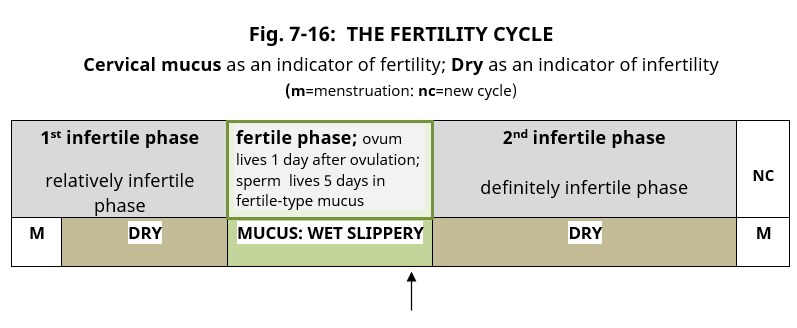What fertility indicator is best to help achieve pregnancy?
Women are fertile for about one third of an average cycle. The only fertility indicator that tells the woman when in her menstrual cycle she is potentially fertile is the mucus symptom. The cervical mucus indicator is therefore the most important sign of fertility.
Once the woman has become familiar with her own personal cervical mucus pattern, (fertility Awareness) the couple can use the fertile time of the cycle to achieve pregnancy.
Planning a family naturally – Cervical Mucus
The woman can identify when the fertile phase begins by the presence of mucus at the opening of the vagina either by the sensation it causes there, or by observing its appearance as she can see the mucus on white toilet paper when she wipes herself before and after she passes urine. The mucus discharge is present for six days immediately before ovulation and it dries up after ovulation.

The mucus ‘build-up’ to Peak day during the six days before ovulation:
In an average cycle when the menstrual period has finished, the woman notices that she has a sensation of dryness at the opening of the vagina, (called the vulva), which lasts two or three days. Then over the following six days she notices the ‘build-up’ of mucus at the vulva.
She first notices the presence of mucus as a sensation of moistness or dampness at the opening of the vagina and she observes that the mucus has a thick and opaque appearance. Then two or three days later the mucus changes to a wet, slippery, lubricative sensation at the vulva; it is now more copious and has a clear, stretchy, raw-egg-white like appearance, which is present for the next 2 or 3 days ending on ‘Peak’ day. The presence of this stretchy mucus with the slippery sensation indicates the time of maximum fertility but the presence of any mucus is a sign of potential fertility. (for pictures of mucus, see Pictures & Diagrams page 11).
Peak day:
Peak day is the last day of slipperiness and it only be identified in retrospect when there has been a definite change to a sensation of dryness at the vulva or to an absence of mucus at the vulva. Maximum fertility occurs at the time of ovulation when the ovum is released from the ovary into the fallopian tube and is available for fertilization. It has been shown that Peak day is closely related to the day of ovulation.1,2 The life span of the ovum after ovulation is 24 hours, but despite this brief life-span of the ovum, nature has designed that the fertile phase of the woman’s cycle is increased by the ability of sperm to survive in stretchy clear mucus, (S mucus), for up to five days.
When is the optimum fertile time?
Therefore to achieve pregnancy intercourse should occur on the days when there is a sensation of slipperiness at the vaginal opening and the mucus has a stretchy, clear appearance like raw-egg-white, or when the sensation of slipperiness is present and little or no mucus is present at the vulva.
The presence of stretchy slippery mucus, (called S mucus) is essential to achieve pregnancy, as it transports and nourishes sperm. Even if the woman is ovulating she cannot get pregnant without the presence of fertile-type S mucus.
Difficulty in recognizing the mucus symptom?
In the case of women who have difficulty recognising the mucus symptom the couple should use the days when there is any sign of mucus at the opening of the vagina such as a sensation of moistness even if short lived. Pregnancy cannot occur without mucus but only a tiny amount of mucus is required and such a small amount of mucus may have escaped observation, hence the importance of observing the sensation as well as the appearance of mucus. In fact to achieve a pregnancy the couple should use any or all of the days that a sensation of moistness, wetness or slipperiness is present at the vulva, or when mucus itself is observed at the vulva.
The World Health Organization in a study of the ‘Ovulation Method’ of NFP found that 90% of women were able to distinguish their mucus pattern during the first cycle.5
If the mucus symptom is hard to define – an Ovulation Monitor device may help
For those women whose mucus symptom is unclear, modern technology has developed various cycle monitor devices to aid in the detection of ovulation which the woman can use at home. One such is a home kit to measure the levels of luteinizing hormone (LH) in the urine daily, and is a reliable way to detect ovulation.4
Does intercourse at the fertile time always result in pregnancy?
The answer is NO. Wilcox et al, in their article in the New England Journal of Medicine in 1995, found that conception occurred only when intercourse took place during the six-day period that ended on the estimated day of ovulation. The probability of conception ranged from 10% when intercourse occurred five days before ovulation to 33% when it occurred on the day of ovulation itself.3 What is interesting in their study is that even when intercourse occurred when everything seemed ‘right’ in a particular cycle, 63% of women did not conceive. Wilcox et al also found that there was no support for a recommendation that normal couples seeking pregnancy should limit the frequency of sexual intercourse.
Is the temperature chart any help in achieving pregnancy?
The woman who has learned to record and interpret the changes in her Temperature Chart during her cycle, can recognize from the temperature pattern whether or not she is ovulating. This is reassuring to know for couples who wish to achieve pregnancy. However by the time the thermal shift (which indicates ovulation) has occurred, it is too late to use this as a sign of fertility as the ovum lives for just 24 hours and is only fertilizable for 12-16 hours within that 24 hour period. Therefore the mucus symptom before ovulation is the indicator of choice for the woman to help achieve pregnancy. The temperature chart also confirms pregnancy, as the higher-phase temperature that stays elevated for 21 days or more after ovulation is indicative of pregnancy.
Women who wish to conceive after coming of the Pill:
Women are advised to defer pregnancy for three months after stopping the Pill, as it may take three months or more for all the synthetic steroid hormone to be excreted from the body. (See section on ‘After stopping the Pill’).
When is medical referral indicated?
If a couple has not achieved pregnancy following six months of regular intercourse during the fertile time of apparently normal cycles, they should consult their doctor.
Pre-Conceptual Advice
The following recommendations on, (i) Folic Acid & Pregnancy, (ii) Rubella (German Measles) & pregnancy, are taken from the HSE website,6 and the ‘NHS choices’ website.7
Folic Acid when planning pregnancy6
According to the HSE, “It’s important to take a folic acid supplement (vitamin B9) for at least 3 months before you become pregnant. Folic acid supports your baby’s spine and brain development. Your baby’s spine develops fully during the first month of pregnancy. Folic acid helps reduce the risk of neural tube defects (NTDs) like spina bifida.6
Doctors advise that you continue to take a folic acid supplement throughout your pregnancy.6
The recommended dose is 400 micrograms of folic acid supplement every day. Ask your pharmacy about the best product for you.6
It is not possible to get the amount of folic acid you and your baby need from food alone. Your body will be drawing on all your nutrients when you become pregnant.”6
In cases where there may be a higher risk of having a baby with a NTD, a higher supplement of folic acid (5 mg) may be recommended but discuss this with your GP.6.7 Such cases include those couples who have a family history of NTD or if the woman herself is taking anti-epileptic medication.6,7
Rubella (German Measles) & Pregnancy (MMR Vaccine)6:
The HSE state the following in their website, “Make sure you are protected from rubella (German Measles), as infection in early pregnancy can lead to serious birth defects and miscarriage.6,7
If you do not have proof that you have been vaccinated against rubella, discuss it with your GP and they’ll arrange a blood test to check if you are immune, and can arrange vaccination if necessary.6,7
Ireland is thought to be free of endemic rubella. But the virus still exists in other countries. You could still get it if it returns to Ireland.6
If you are planning to be vaccinated against Rubella:
You must get the vaccine at least one month before you get pregnant.6
MMR is a live vaccine. It cannot be given during pregnancy.6
Avoid getting pregnant for one month after you get the vaccine.6
Discuss with your doctor regarding the vaccines available.
References:
- Flynn AM, Lynch SS; ‘Cervical mucus and identification of the fertile phase of the menstrual cycle’ page 658; Br J of Obstet &Gynec; August 1976; vol 83; 656-659.
- Hilgers TW, Abraham GE, Cavanagh D; ‘Natural Family Planning – 1. ‘The Peak Symptom and Estimated Time of Ovulation’ Obstet & Gynec Nov 1978, vol 52, no 5 p 575-582.
- Wilcox AJ, Weinberg CR, Baird DD; ‘Timing of sexual intercourse in relation to ovulation’; N Engl J Med 1995, 333, no.23 p 1517-21.
- Guida, M et al; “Efficacy of methods for determining ovulation in a natural family planning program; Fertil & Steril; vol 72, no 5, Nov 1999, p 900-904.
- World Health Organization; ‘A prospective multi-centre trial of the Ovulation Method of Natural Family Planning 1; The Teaching Phase’; Fertility & Sterility; vol. 36, no 2, Aug 1981; p152-158.
- HSE, Pregnancy and Birth, Trying for a baby. (May 2023)
- ‘NHS Choices’, Rubella. (May 2023)


